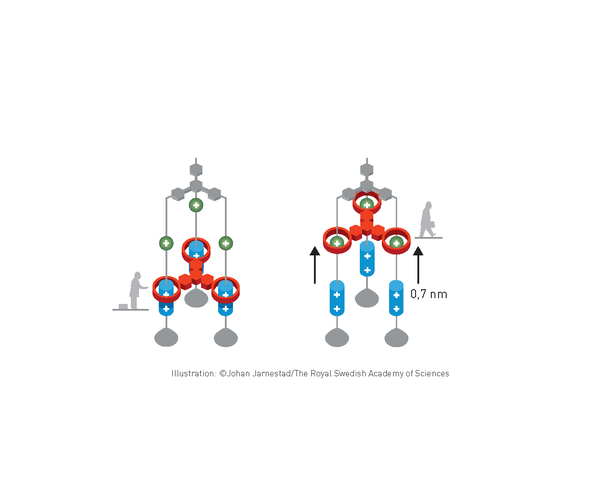Bernard Feringa said he was shocked “when we started a molecular machine for the first time and saw motion.” The chemist said he was equally shocked this morning when he got a call from Stockholm telling him that his work netted him part of this year’s Nobel Prize in Chemistry.
Feringa shares the prize with chemists Jean-Pierre Sauvage and Sir. J. Fraser Stoddart as well as about $923,000 in prize money for building machines on the tiniest of scales—the nanometer scale, a thousand times smaller than the width of a hair, or a billionth of a meter. Molecular motors and elevators and muscles, and even miniature four-wheel-drive cars, were cited by the Nobel Committee as some of the inventions of the three scientists, who mastered construction techniques and the ability to create energy to make things move.
Scientists on the Nobel Committee, and Feringa himself in an interview, emphasized the practical applications had not yet been worked out, but perhaps they were being overly modest. Nanoscale machines based on these design principles have already begun to shape the future of medicine: Scientific American recently reported on nanobots that can be sent through blood vessels and nanomaterials that can monitor vital organ health. And some of Stoddart’s work was highlighted in an article in the magazine in 2007.
On supporting science journalism
If you're enjoying this article, consider supporting our award-winning journalism by subscribing. By purchasing a subscription you are helping to ensure the future of impactful stories about the discoveries and ideas shaping our world today.
Sauvage was born in 1944 and works at the University of Strasbourg in France. Stoddart was born in 1942 and is now at Northwestern University in Evanston, Ill. Feringawas born 1951 and is at the University of Groningen in the Netherlands.
Sauvage was the first to take a big step toward a tiny machine in 1983, when he linked two ring-shaped molecules to form a chain, one component free to move around the other, rather than fixed in place. For a machine to be able to perform a task, its parts must be able to move relative to one another. The two interlocked rings fulfilled this requirement, said Olof Ramstrom, a chemist at the KTH Royal Institute of Technology in Stockholm and a member of the Nobel Committee for Chemistry.
Then, in 1991, Stoddart showed molecular parts could be controlled. He and his team threaded a molecular ring onto a thin molecular axle and moved it to different parts and then back. The ring remained around this axle because the two components had complementary electron groups that kept them together yet loose enough to move. When Stoddart added heat—exciting the electrons on various segments of the axle-- the ring slid up and down. This type of control set the stage for devices including a molecular elevator, going up and down, and a molecular muscle that can expand and contract.
Feringa used the idea of added energy to create spinning motions, essential for a true motor. In 1999 he got a molecular rotor blade to spin in one direction, overcoming the basic random movements of molecules. By 2014 he had this motor spinning at 12,000 revolutions per second. He also has used motors to spin a glass cylinder that is 10,000 times bigger than the motor itself. And his team has linked several motors and axles to create a four-wheel-drive "nanocar."
What does this all mean for changing the world we live in? Many observers liken the situation to the late 19th century, when scientists had just started to create much larger motors powered by electricity. Today we have power drills and washing machines and cars. Feringa drew a comparison to the Wright brothers. Once they built a flying machine, he said, people reacted happily but also wondered what it could be used for. “And today we have Boeing 747s,” the chemist says. The possible applications for molecular machines range from robots that hunt cancer in the body to tiny energy-storage devices to power computers, he thinks.
Donna Nelson, a chemist and president of the American Chemical Society, says, “I think this topic is going to be fabulous for science. When the Nobel Prize is given it inspires a lot of interest in the topic by other researchers. It will also increase funding.” Nelson also notes this particular area, tiny machines, “will be fascinating for kids. They can visualize it and imagine a nanocar. This comes at a great time, when we need to inspire the next generation of scientists.”
And inspiration creates results. Today’s prize-winners were inspired, as were many in their profession, by a 1959 lecture by another Nobelist, physicist Richard Feynmann, who talked about the potential for construction at the smallest scales. His talk was titled “There’s Plenty of Room at the Bottom.” Today that lower room proved to be a route to the top of the scientific world.
